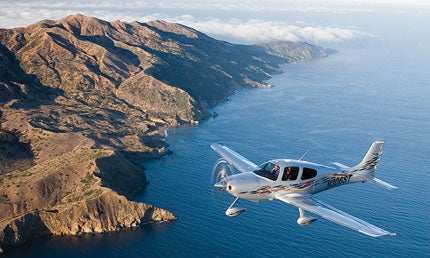From The Editor: Over Water
It never seems to matter what headset I’m wearingâwhen I’m flying over a large stretch of water, I can hear every single sound that the engine makes.
 |
It never seems to matter what headset I'm wearing---when I'm flying over a large stretch of water, I can hear every single sound that the engine makes. For better or worse, I even hear sounds that the engine doesn't make! Like Superman, whose super-hearing powers let him focus in on specific sounds, such as a person's heartbeat even if they're in another city, I can perceive every rotation of the crank shaft, even with noise cancelling turned on.
The longest distance I've flown over water is 212 nm, from the Turks and Caicos Islands to Haiti, where Plane & Pilot delivered supplies to earthquake victims. I listened to the engine with my superhero powers, and checked cylinder head temps obsessively. My copilot didn't seem quite as excitable. In fact, he seemed pretty much at ease. What was wrong with me (aside from the vast shark-infested waters below)? Our engine didn't know if we were over water or land, a fact that should have been comforting.
My more common (and stress-free) water crossing is an afternoon jaunt to Southern California's Catalina Island, a relatively short 26 nm above the Pacific. There only are a few minutes when land isn't within gliding distance, and boats are a common sight. It's hard to fathom what it would be like crossing an entire ocean. Yet Senior Editor Bill Cox has done just that, more than 200 times! His typical single-engine ferry flight entails 13 to 15 hours to cover 1,800 nm to Ireland. In order to maintain his sanity, Bill says he has learned to ignore all the "little clicks and ticks and whirrs and tinkles and buzzing and pitch changes and occasional burps." You do become accustomed to it, he maintains, but you never get totally comfortable. In this issue, Bill lets us in on what an ocean crossing is really like. As he suggests, you may really enjoy such an ambitious endeavor. Or not.
This month's guest columnist also knows a thing or two about flying over water. Chris Aultman's stomping ground is the Southern Ocean, an inhospitable and volatile environment of 7-foot swells, minus-40-degree temps and powerful winds. As aviation director for Sea Shepherd Conservation Society, he flies an MD500E helicopter in an effort to stop illegal whaling activities, a mission brought to the public's attention by Animal Planet's successful television series Whale Wars. Aultman, whose flying career spans the Gulf War, discusses his responsibilities of search and rescue, aerial reconnaissance and aerial filming.
Terra firma under your wings may be a reassuring sight, but safety is equally as important. Contributor Marc Lee joined Aviat Aircraft's Stu Horn and a group of Husky pilots on a flying adventure in Wyoming, navigating tight canyons and landing on impossibly narrow airstrips. The key to backcountry flying, as Marc found out, is mastering airspeed and knowing how to read the wind. Maintaining full control means constantly adjusting flap setting from two notches to one notch to no flaps, as needed. On final, ultra-slow speeds with plenty of power are fundamental, and touchdowns are more about "putting it down" than landing. In "Backcountry Odyssey," Marc tells why the 14 hours logged in the Husky made for his best flying adventure yet.
Reader Matt Liknaitzky's most memorable flight was confined to an area of just 1 sq. km. Diving into the aerobatic box in his Christen Eagle biplane at his first competition, he was all nerves. For someone whose aviation accomplishments include a solo flight from Florida to California in a weight-shift microlight, Matt is not easily intimidated by challenges. But in the end, the pressures that he was feeling during the contest were nearly all self inflicted, and the rewards were many. What's a flight you'll never forget? Share you story with us at editor@planeandpilotmag.com for a chance to be publishing in an upcoming issue.

Subscribe to Our Newsletter
Get the latest Plane & Pilot Magazine stories delivered directly to your inbox






